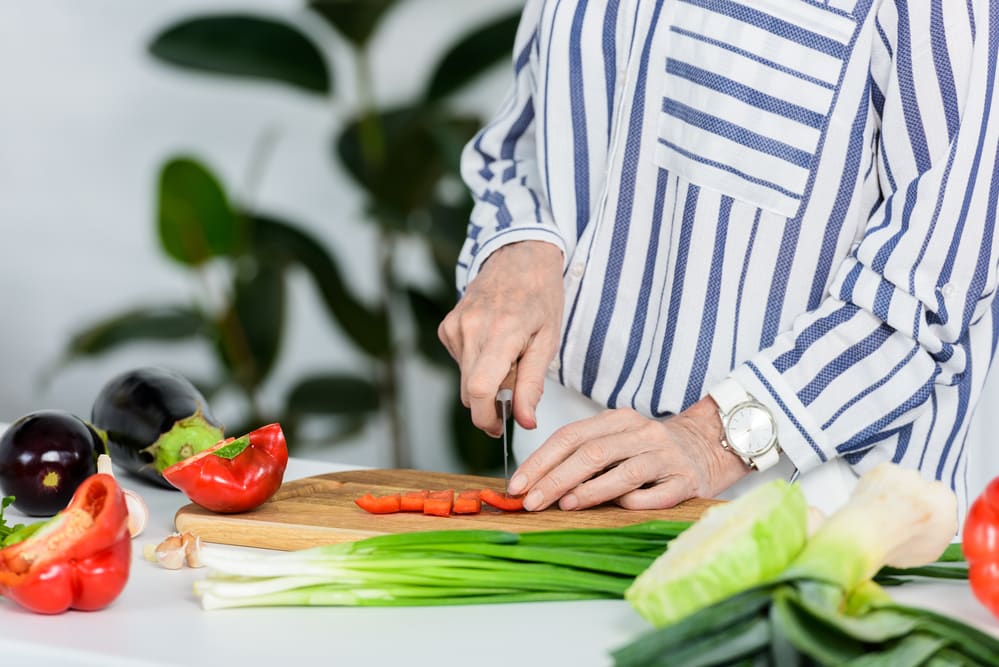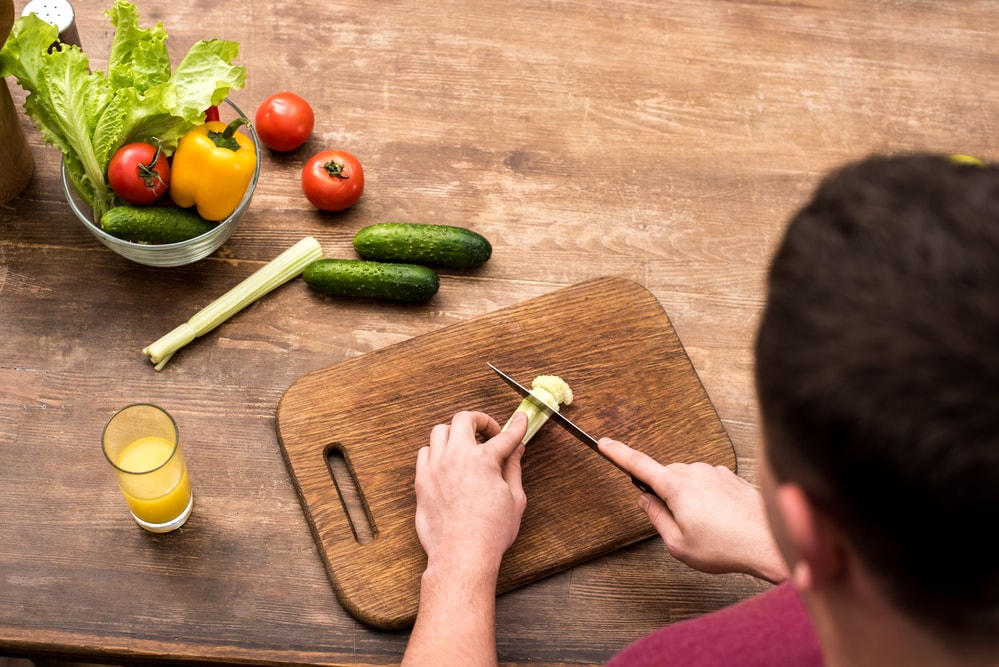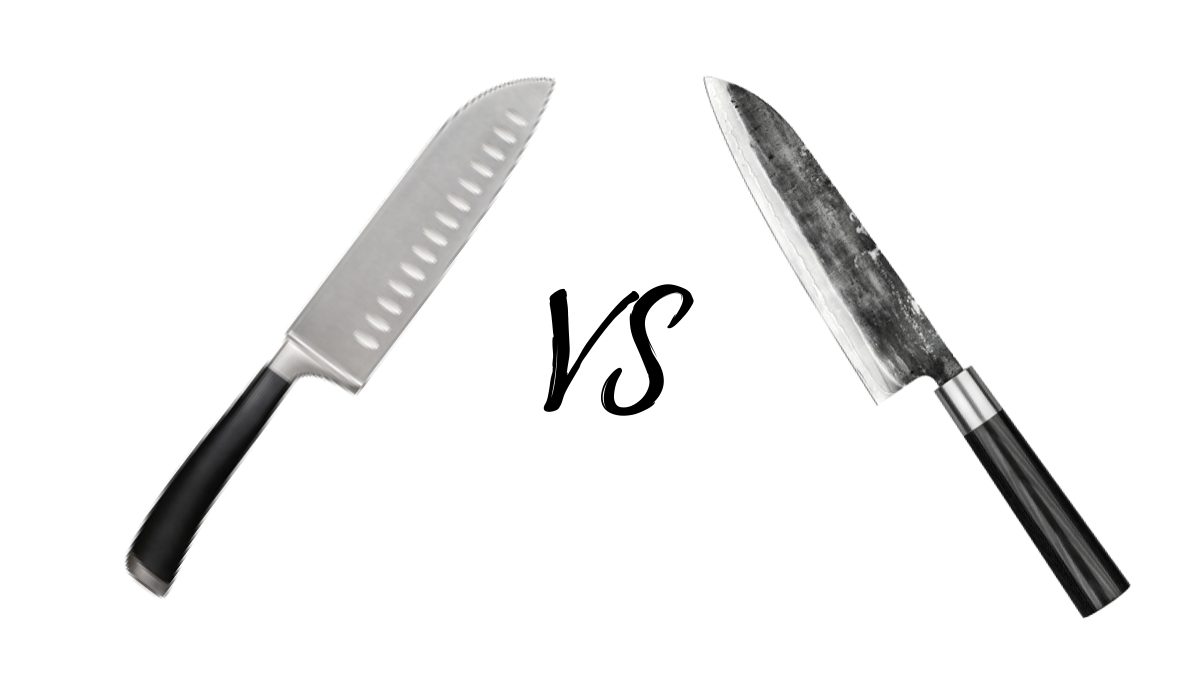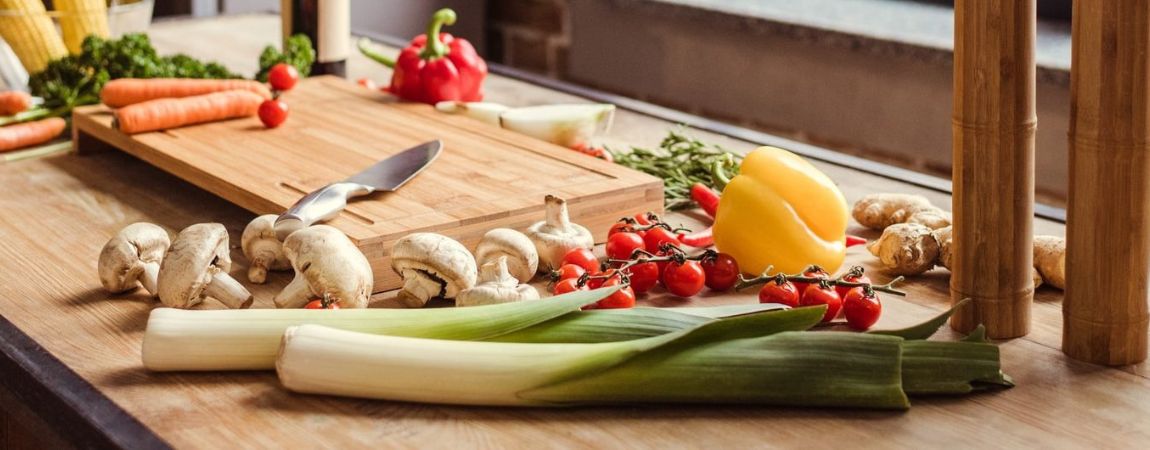Gyuto VS santoku – which one should you choose? Finding the right knife can be more challenging than some newbie chefs expect. On this page, we’ll cover the basics of both gyuto and santoku to help you find options that work for you.
The better you understand your equipment, the easier it will be to perform at your best!
Gyuto Knife Overview

This Japanese powerhouse is designed to be the most versatile knife in your kitchen. The word “gyuto” means “beef sword/ knife” in Japanese which hints at its roots in Japanese culinary tradition.
In a modern context, the mostly flat blade, average length, and pointed tip of the gyuto make it a phenomenal alternative to a western chef’s knife. In fact, they first emerged as an option in Japan when French and German knives were imported into the country.
Gyuto Chef’s Knife Shape
One note that’s worth making here is that with both gyuto and santoku knives, you’ll often be using an up-and-down motion when chopping. This is thanks to their flat blades which can be difficult to rock back and forth on your cutting surface.
If you prefer to use the more western rocking motion in the kitchen, you could look into gyuto knives that use a French profile. This increased curve can make back-and-forth rocking much easier and is one point of difference when choosing gyuto over santoku.
Weight
One of the things that makes gyuto knives so great is their weight – they’re super lightweight thanks to the materials used for their handles and blades. While this can make hacking through bones and denser meats a challenge, it makes it trivial to blitz through jobs like mincing, slicing, and dicing.
Gyuto Knife Handle
Another factor that’s worth keeping in mind with both santoku and gyuto knives is their handle designs. It’s not uncommon for Japanese knives to use oval or hexagonal handles made from wood.
While these can look stunning, they can feel a bit uncomfortable to the uninitiated. The good news is that it’s often possible to find gyuto knives with a more “western style” full-tang, riveted handle.
Gyuto Knife Uses
- Most of what a western chef’s knife can do with more speed
- Fast slicing and dicing
- Raw, deboned meat prep
- Vegetable preparation
Gyuto Knife Basic Stats
- Blade length starts at 7 and goes all the way up to 12
- Blades between 1 and 5 mm thick
- HRC of 60 – 63
Santoku Knife Overview

If you’re concerned that santoku knives won’t live up to the versatility of their gyuto counterparts, don’t be – the name “santoku” means “three virtues” in Japanese. These virtues are said to be cutting, slicing, and dicing.
Some suggest that these virtues may in fact be the three pillars of Japanese cuisine: rice, vegetables, and fish. Regardless, santoku knives are exceptionally versatile tools that can be used for a huge variety of tasks in the kitchen.
Sheep’s Foot Shape
Something that immediately distinguishes santoku knives from gyuto knives is their “sheep’s foot” shape. The curved, less pointed tip of these knives are one point of difference VS gyuto knives.
For the safety-conscious cook, this design can help reduce the risk of accidental pierces or stabs when working.
Length
On average, santoku knives tend to measure in a touch shorter than your typical gyuto. The extent to which this matters will depend on the type of cooking you’re doing. For tasks that require a bit more dexterity, the shorter length could be an advantage.
Price
In general, santoku knives can usually be found for less money than their gyuto cousins. This of course depends on your region and luck but keep your eyes peeled when shopping to pick yourself up a bargain!
Uses for Santoku Knives:
- Dicing, slicing, and cutting
- Preparing traditional Japanese meals
- Most kitchen tasks
- Mincing
Santoku Knives Basic Stats:
- Blades 6 – 8-inches long
- 1.5 – 3.5 mm blade thickness
- 56 – 59 HRC
Gyuto Knives vs Santoku Knives – The Differences
One key difference between gyuto knives and santoku knives is their history. Santoku knives were invented in Japan as an evolution of the earlier nakiri knife. Gyuto knives emerged when French and German knives were first imported into the country and Japanese knife makers took note.
| Knife | Gyuto | Chef’s Knife |
| Blade Length | 7 – 12 inches | 6 – 8 inches |
| Blade Thickness | 1 – 5 mm thick | 1.5 – 3.5 mm thick |
| Flexibility | Low | Some flex |
| HRC | 60 – 63 | 56 – 59 |
| Main Purpose | Almost anything a western chef’s knife can do with more speed | General kitchen work |
We explore some other differences below:
Length
On average, santoku knives are a touch shorter than gyuto knives. Keep this in mind when shopping.
Shape
If you need a knife with a sharp pointed tip, a gyuto knife is probably the best option for you. If you want to avoid accidentally piercing your hand or the food you’re cutting, the sheep’s-foot shape of santoku knives could serve you well.
Gyuto Knives vs Santoku Knives – Which One Should I Choose?
The bottom line here is that many people won’t notice a huge difference between gyuto VS santoku knives. Both options are remarkably versatile and can work very well for a broad variety of kitchen tasks.
If you want something a touch shorter with a more blunted tip, look into santoku knives. If you could use the extra length and sharper tip, gyuto is probably the way to go.
Gyuto Knife Recommendation
We don’t think you’ll be disappointed with this gyuto knife:
It’s astonishingly affordable, well-performing, and durable.
More – best gyuto knife.
Santoku Knife Recommendation
If santoku knives are more your speed, we’re in love with this one:
– Mercer Culinary M20707 Genesis 7’’ Santoku Knife
It’s a dependable powerhouse from the legendary Mercer brand.
More – best santoku knives in 2022.

Final Thoughts
Whether you opt for the added length and sharp tip of a gyuto or the shorter, sheep’s foot santoku, we hope your choice serves you well for many years to come. Happy cooking!




Post Your Thoughts